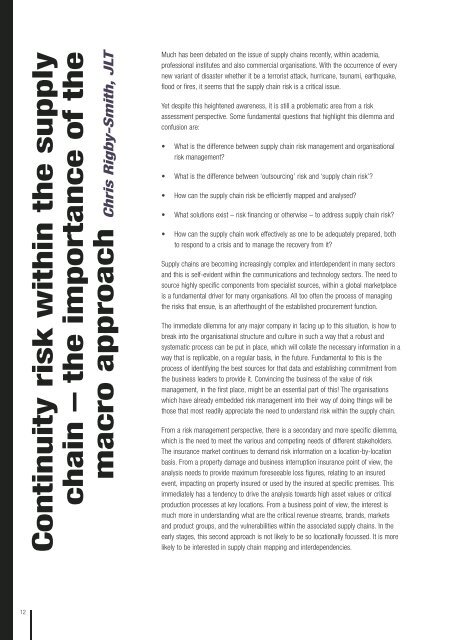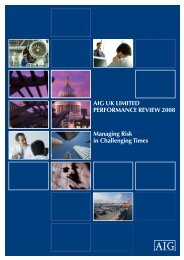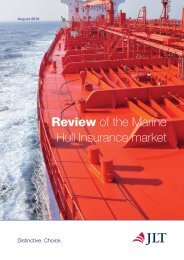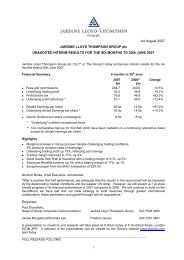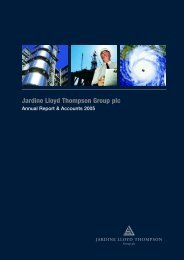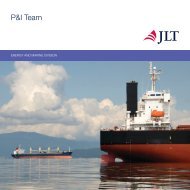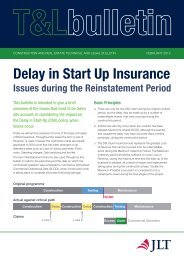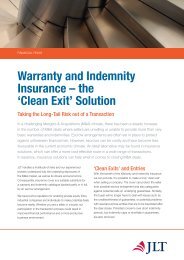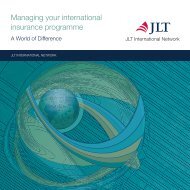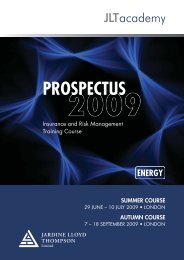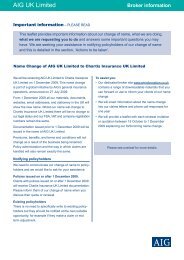CommTech 2006 Forum Newsletter - JLT
CommTech 2006 Forum Newsletter - JLT
CommTech 2006 Forum Newsletter - JLT
You also want an ePaper? Increase the reach of your titles
YUMPU automatically turns print PDFs into web optimized ePapers that Google loves.
Continuity risk within the supply<br />
chain – the importance of the<br />
macro approach Chris Rigby-Smith, <strong>JLT</strong><br />
Much has been debated on the issue of supply chains recently, within academia,<br />
professional institutes and also commercial organisations. With the occurrence of every<br />
new variant of disaster whether it be a terrorist attack, hurricane, tsunami, earthquake,<br />
flood or fires, it seems that the supply chain risk is a critical issue.<br />
Yet despite this heightened awareness, it is still a problematic area from a risk<br />
assessment perspective. Some fundamental questions that highlight this dilemma and<br />
confusion are:<br />
• What is the difference between supply chain risk management and organisational<br />
risk management<br />
• What is the difference between ‘outsourcing’ risk and ‘supply chain risk’<br />
• How can the supply chain risk be efficiently mapped and analysed<br />
• What solutions exist – risk financing or otherwise – to address supply chain risk<br />
• How can the supply chain work effectively as one to be adequately prepared, both<br />
to respond to a crisis and to manage the recovery from it<br />
Supply chains are becoming increasingly complex and interdependent in many sectors<br />
and this is self-evident within the communications and technology sectors. The need to<br />
source highly specific components from specialist sources, within a global marketplace<br />
is a fundamental driver for many organisations. All too often the process of managing<br />
the risks that ensue, is an afterthought of the established procurement function.<br />
The immediate dilemma for any major company in facing up to this situation, is how to<br />
break into the organisational structure and culture in such a way that a robust and<br />
systematic process can be put in place, which will collate the necessary information in a<br />
way that is replicable, on a regular basis, in the future. Fundamental to this is the<br />
process of identifying the best sources for that data and establishing commitment from<br />
the business leaders to provide it. Convincing the business of the value of risk<br />
management, in the first place, might be an essential part of this! The organisations<br />
which have already embedded risk management into their way of doing things will be<br />
those that most readily appreciate the need to understand risk within the supply chain.<br />
From a risk management perspective, there is a secondary and more specific dilemma,<br />
which is the need to meet the various and competing needs of different stakeholders.<br />
The insurance market continues to demand risk information on a location-by-location<br />
basis. From a property damage and business interruption insurance point of view, the<br />
analysis needs to provide maximum foreseeable loss figures, relating to an insured<br />
event, impacting on property insured or used by the insured at specific premises. This<br />
immediately has a tendency to drive the analysis towards high asset values or critical<br />
production processes at key locations. From a business point of view, the interest is<br />
much more in understanding what are the critical revenue streams, brands, markets<br />
and product groups, and the vulnerabilities within the associated supply chains. In the<br />
early stages, this second approach is not likely to be so locationally focussed. It is more<br />
likely to be interested in supply chain mapping and interdependencies.<br />
12


